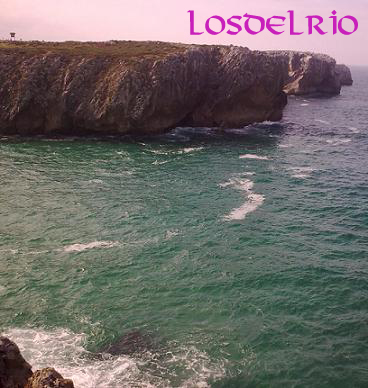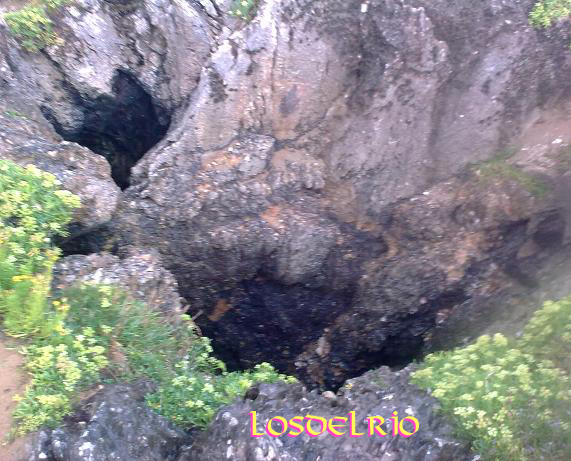|

Video give up by Balarum \ Video cedido por Balarum

 Version en castellano más abajo Version en castellano más abajo
The "bufones" (blowholes) declared Natural Monument, are located on the platform between Llanes and Unquera and have a karst morphology, that the periodic phenomenon of the tides, is responsible for the main singularity of the place.
Seawater ascends with pressure through the perforations carved on the rocks due to the erosion by the sea. When the water ascends, till spurts of up 20 metres high, there is a kind of noise similar to a whistling or snort which gives name to this phenomenon. In spanish from "bufido" (snort), we obtain "bufón" (blowhole) the special name given to that sea rocky holes.
The formation of the bufones is based on the disintegration of the limestone by the effect of rainwater erosion. The rain seeps through small fractures or zones of weakness till sea level. The erosive action of the sea makes the enlargement of the original small cavities, leading over time to form a cave in communication with the vertical duct. When the waves reach the cliff, air or water on the cave is compressed at high pressure and they come out the outside. If the sea is calm, vents of underground cavities are confined to remove the air compressed in the galleries from the blows of the waves. But in the days of white water "the bufones" become a spectacle that produces admiration and awe. Then the air and water tight in these narrows underground escape together through the cracks of the dome thinned. The land opens to the sky spitting bits of sea with deafening noise and a slight "Orbayu" (Asturian thin light rain) salt water the fields
The best-known Los Bufones de Pria, located near the town of Llames, aren't those with the highest water jet, but you could see more than 5 bufones making choir to its star tenor bufon "El Bramadoriu" can be heard roaring even from Sierra del Cuera. There is a highly recommended the Coast Path Bufones de Pria, for those who enjoy the contact with nature and watching this outdoor natural spectacle. Leaving from Llames you reach the broader field of bufones of the Asturian coast. Here you can download the coastal route in gpx format.
West of Los Bufones de Pria is the wonderful beach-cove of Guadamía, worth visiting, just in the same place that we recommend as parking of bufones N43 27.306 W4 58.867 but places are limited.
In these coordinates: N43 27.579 W4 58.699 you can listen "Breathing of the Beast"
Location
They are in LLames de Pria 23 kms to the West of Llanes. You must take exit 319 (Pria-New-Ovio-Cardoso) on A8 highway and after 2 km on AS-263 heading West to Ribadesella, deviate at 2 kms from Belmonte exit toward Llames and Guadamía beach.

The cache
To validate this cache you must:
1) Answer this question correctly: In the specified coordinates of Earthcache there is a information display with a map of bufones' field and it has one area with a yellow perimetral mark. What are the names of the 3 geographical locations that are within?
2) Answer this question correctly: Very close to the first information display there is a wall chart panel. How many bufones (blowholes) are drawn on it?
3) Answer this other question correctly: type of ground or terrain which due to erosion has originated "the bufones".
4) Take a picture with your GPS close to one of the bufones provided you don't put yourself in danger or other people to make that picture. Try to be original in its execution.
Once you have the answers please email me through my profile. You don't need my confirmation about the correct answers to log. Please log your visit directly, including your voluntary photo and if there is some problem about the matter I'll contact with you.
Logs that include the answers will be deleted without notice.

HINTS
The best time of year to enjoy "Los bufones" is in autumn or winter and at high tide.
You can see high tides time here: ASTURIAS TIDE TABLES (SPANISH)
Warning! Don't lean out the cliff since the ground cracked could give way. In the stormy days bufones are extremely dangerous and should be viewed from a distance to avoid accidents.
PLEASE BE CAREFUL!


Los bufones, declarados Monumento Natural, están situados sobre la plataforma de la rasa entre Llanes y Unquera y presentan una morfología kárstica, que con el fenómeno periódico de la mareas, es la responsable de la principal singularidad del lugar.
Los bufones son grietas y chimeneas abiertas en la costa y conectadas con simas marinas por las que el agua del mar penetra a presión, formando surtidores de agua pulverizada visibles desde el exterior y que pueden alcanzar más de 20 metros de altura.
La formación de los bufones se basa en la disgregación de la roca caliza por efecto de la erosión del agua de lluvia. La lluvia penetra por pequeñas fracturas o zonas de mayor debilidad hasta el nivel del mar. La acción erosiva del mar favorece el agrandamiento de las pequeñas cavidades originales, provocando con el paso del tiempo que se forme una cueva en comunicación con el conducto vertical. Con la llegada de las olas, el aire o el agua que existe en la cueva se comprime y sale a gran presión al exterior. Si la mar esta en calma los respiraderos de las cavidades subterráneas se limitan a expulsar el aire, comprimido en las galerías por los golpes del oleaje. Sin embargo en los días de fuerte marejada los bufones se transforman en un espectáculo que produce admiración y temor. Entonces el aire y el agua, apretados en esas angosturas subterráneas, escapan juntos por los resquicios de la adelgazada bóveda. La tierra se abre escupiendo al cielo trozos de mar con ensordecedor ruido y un ligero orbayu de sal riega los campos.
Los más conocidos, los bufones de Pría, situados próximos a la población de Llames, no son los que tienen el chorro de agua más alto, pero podréis ver más de 5 Bufones haciendo el coro a su Bufón tenor estrella "El Bramadoriu".
Existe la muy recomendable Senda Litoral de los Bufones de Pría, para todos aquellos que quieran disfrutar del contacto de la naturaleza y observando al aire libre este pequeño espectáculo natural. Saliendo desde Llames se llega al campo de bufones más amplio de la costa asturiana. Aquí puedes descargarte la ruta costera en formato gpx
Al Oeste de los Bufones de Pría está la maravillosa cala-playa de Guadamía, digna de visitar, justo en el mismo lugar que recomendamos como parking de los bufones N43 27.306 W4 58.867, aunque las plazas sean escasas.
En las coordenadas: N43 27.579 W4 58.699 podréis escuchar "La respiración de la bestia".
Localización
Están en Llames de Pría, a 23 Km. de Llanes hacia el Oeste, deben coger la salida 319 de la A-8 (Pría-Nueva-Ovio-Cardoso) y a 2 Km. por la AS-263 dirección Oeste hacia Ribadesella, desviarse a 2 Km. de la salida en Belmonte hacia Llames y la Playa de Guadamía.
.
El cache
Para realizar este caché deberéis:
1) Responder correctamente a esta cuestión: En las coordenadas especificadas del Earthcache hay un cartel con un mapa del campo de bufones y en él hay un area marcada en amarillo. ¿Cuales son los nombres de las 3 localizaciones geográficas que se encuentran dentro?
2) Responder correctamente a esta cuestión: Muy cerca del primer cartel informativo hay otro vertical ¿Cuantos bufones aparecen dibujados en él?
3) Responder correctamente a esta cuestión: Tipo del terreno que debido a la erosión ha originado los bufones.
3) Publicar una foto vuestra con el gps en alguno de los bufones, siempre y cuando no os pongáis en peligro ni a vosotros mismos ni a otras personas al realizar dicha foto. Procurar ser originales en su ejecución.

Una vez que tengáis las respuestas por favor enviarme un correo electrónico a través de mi perfil. No necesitáis mi confirmación a las respuestas correctas para loguear el erthcache. Por favor registrar vuestra visita directamente, incluyendo vuestra foto voluntaria y si hay algún problema al respecto me pondré en contacto con vosotros.
Los registros que incluyan las respuestas serán borrados sin previo aviso.
CONSEJO: La mejor epoca del año para disfrutar de "Los bufones" es en otoño e invierno y con marea alta.
Podeis mirar cuando está la marea alta aquí: TABLA DE MAREAS DE ASTURIAS
¡Atención! Es importante guardar cierta distancia de la boca del bufón, ya que el agua puede salir inesperadamente y a mucha presión, arrastrando piedras, madera, algas, etc. Tampoco conviene asomarse al acantilado ya que, al ser un suelo agrietado, podría ceder. En los días de temporal los bufones son extremadamente peligrosos, debiendo contemplarse desde la distancia para evitar accidentes.
¡POR FAVOR SER PRUDENTES!


|